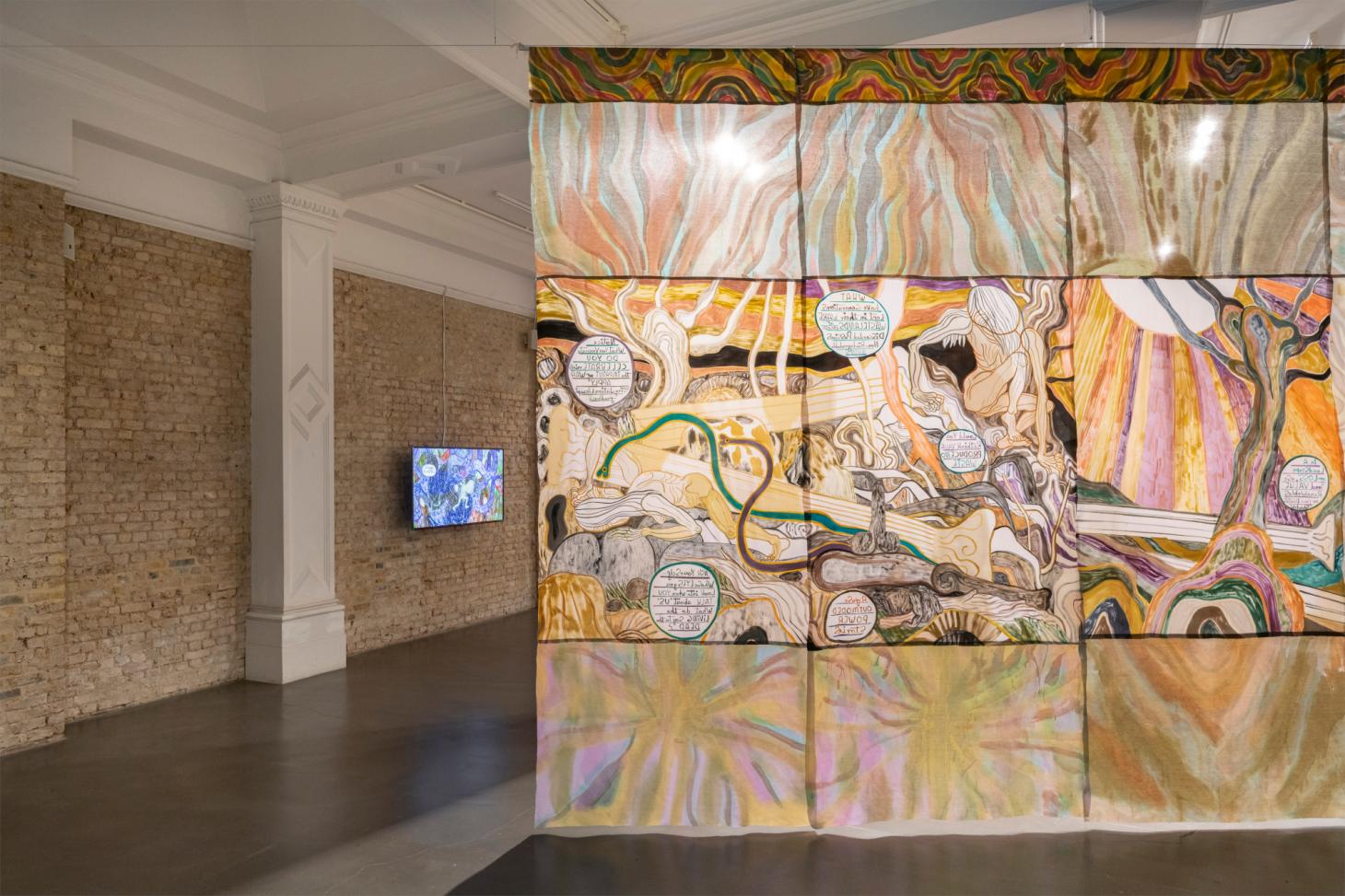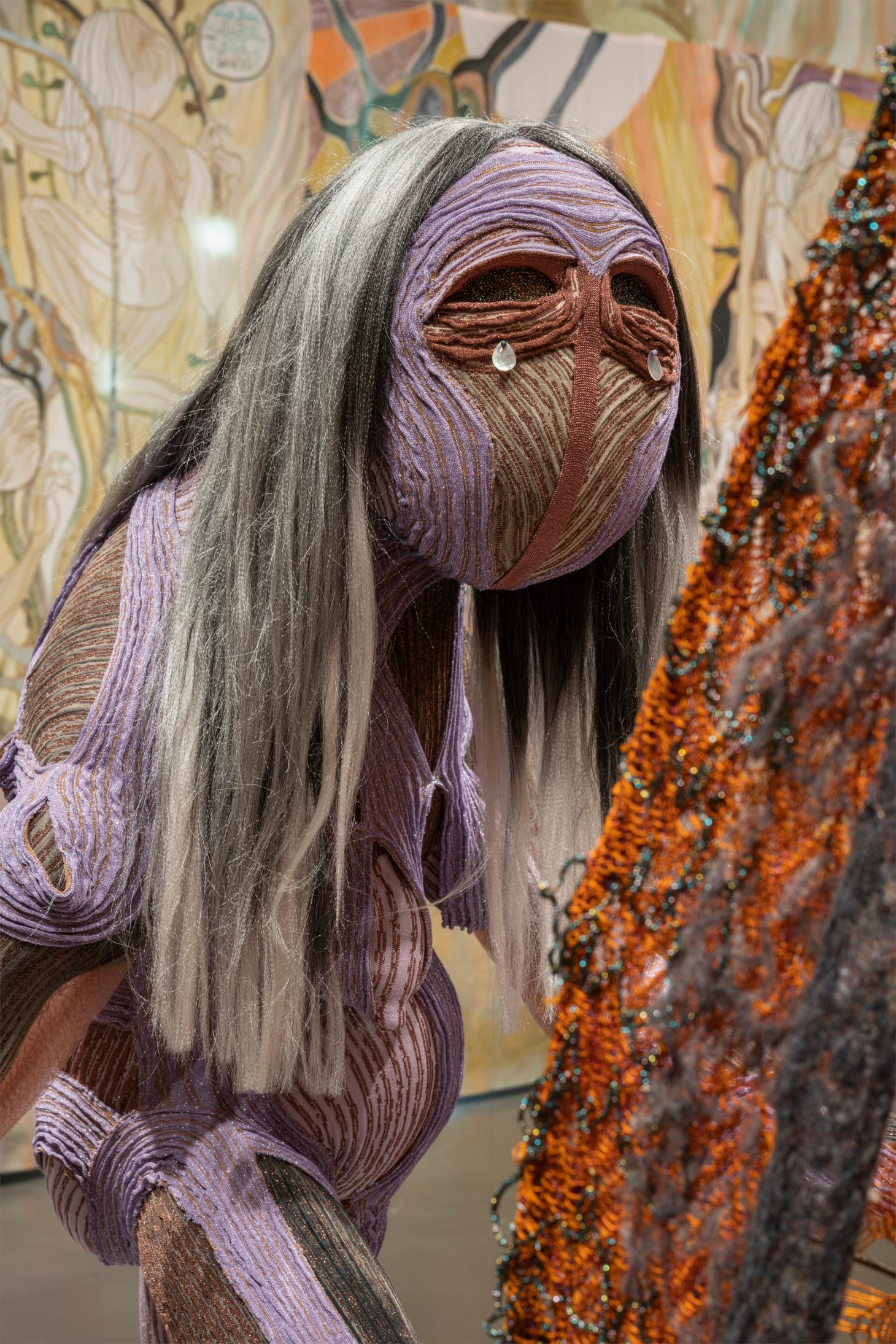Emma Talbot explores Greek myth and femininity at Whitechapel Gallery
In ‘The Age/L’Età’, her Max Mara Art Prize show at Whitechapel Gallery, Emma Talbot imagines a reality where violence is overturned by resolution, nurtured by an elderly female protagonist

The show ‘The Age/L’Età’ is the culmination of Emma Talbot’s six-month residency in Italy, facilitated by Collezione Maramotti in Reggio Emilia, after she was awarded the eighth Max Mara Art Prize for Women, in 2020.
Presented first at Whitechapel Gallery in London before travelling to Collezione Maramotti in October, her exploration delves into the violence of Greek mythology and the balance of permaculture and paganism. Her work leads us to question the ‘role of destruction in the foundations of patriarchy’, explains curator Laura Smith. During her Italian residency, Talbot used knitted sculptures, animations from drawings, huge silk-screen paintings and disorientating soundwork to imagine a world anchored in nature’s wisdom.

Emma Talbot: Max Mara Art Prize for Women, The Trials, 2022. Ruins, 2022. Installation images: © Damian Griffiths
Gustav Klimt’s The Three Ages of Woman, 1905, was the springboard for Talbot’s show. The painting, displayed in 1911 during Rome’s International Exhibition, organised to mark the 50th anniversary of Italian unification (Risorgimento), signifies the progression from tradition to modernity, and the birth of a united state. Able to observe the painting first-hand during her residency, Talbot imagined the elderly woman as emblematic of an old and ‘tired’ Italy. In response, she reframes the character as a saviour in a post-apocalyptic pagan dystopia, rooting her actions in the 12 permaculture design principles and a pagan respect for nature.
At first glance, the show seems overtly feminist and uncomfortable. The loud, humming sounds offer a sense of unease and the images seem complicated – but what else could be expected from such a wide-ranging practice? A little time spent reading about the context of the exhibition sets the scene for Talbot’s imagined world, and is worth the extra moments of effort. It’s a rare treat to dive, layer by layer, into such depth of thought.

Emma Talbot: Max Mara Art Prize for Women, Volcanic Landscape, 2022. Installation Images: © Damian Griffiths
In Ruins and Volcanic Landscape, split across two silk screens, we follow the woman ‘trying to navigate the landscape of broken history’, as Smith explains. The tapestries hanging from the ceiling of Whitechapel Gallery contrast the serene with the brutal, depicting the woman in different forms; she nurtures hurt animals, is a 12-limbed figure busily twisted over swirling backgrounds and peers into cracks in her universe. The tone in the bubbles of speech dotted across the images range from advice that ‘life is a transformative process, keep going, learn and adapt’ to vehemently urging us to ‘use (our) agitations to rise up and survive’. The pieces portray the woman questioning the way of the world, presenting an amalgamation of thoughts that relate us in common moments of meditation.
The facelessness of the woman is important; It enables the character to represent a universal ‘self’ and encourages understanding. In the 25-minute-long animation, The Trials, we see the elderly woman’s response to the mythical Twelve Labours of Hercules. Smith explains that Talbot doesn’t bind herself to conversations around womanhood, touching on ‘epic themes around feminism, age positivity and climate catastrophe’. Rather, she speculates on an alternative story of strength in which matriarchal wisdom prevails over violence. The charmingly awkward stop-start video depicts the woman redirecting power from The Lernean Hydra to more productive means, building trust with and calming The Nemean Lion and coexisting peacefully with The Cretan Bull. She uses patience and empathy to solve problems that Hercules famously blundered through with violence. She draws dystopian parallels between myths and modern-day problems, in turn questioning our role in change. The animations are also sprinkled with text, disjointedly narrating the story in questions such as ‘do you roar, is your rage suppressed?’ and reminding us that ‘your power comes from within’.

Emma Talbot: Max Mara Art Prize for Women, The Age/L'Etá, 2022. Installation Images: © Damian Griffiths
Across her media, Talbot offers finely orchestrated concepts, which nudge gently into one another and will us to question truths about contemporary Western society. The show’s title work, The Age/L’Età, stands proudly in the centre of the room, the elderly woman in full form. Her skin is made from recycled fibres and appears like a muscular armour, her long silver hair frames dark, sparkling eyes which reflect into the portal in front of her. Talbot refers to her sculptures as ‘3D drawings’, they project a dream-like foreign reality, and along with the overwhelming and indistinct sound played throughout the room, the show is disordered, which allows exploration between the works and lets you jump in at any point to piece it all together.
Receive our daily digest of inspiration, escapism and design stories from around the world direct to your inbox.
Overarchingly, ‘The Age/L’Età' is a reminder to reflect. Here, we can ponder Talbot’s fabricated universe, question our internal compass, find solace in resolution and consider ‘how will you survive in this climate?’

Emma Talbot: Max Mara Art Prize for Women, Ruins, 2022. Installation Images: © Damian Griffiths

Emma Talbot: Max Mara Art Prize for Women, The Age/L'Etá, 2022. Installation Images: © Damian Griffiths
Information
Until 4 September 2022 at Whitechapel Gallery, whitechapelgallery.org
‘The Age/L’Età’, Max Mara Art Prize for Women: Emma Talbot, Collezione Maramotti in Reggio Emilia, Italy, 23 October 2022 – 19 February 2023
Martha Elliott is the Junior Digital News Editor at Wallpaper*. After graduating from university she worked in arts-based behavioural therapy, then embarked on a career in journalism, joining Wallpaper* at the start of 2022. She reports on art, design and architecture, as well as covering regular news stories across all channels.
-
 The White House faced the wrecking ball. Are these federal buildings next?
The White House faced the wrecking ball. Are these federal buildings next?Architects and preservationists weigh in on five buildings to watch in 2026, from brutalist icons to the 'Sistine Chapel' of New Deal art
-
 Georgia Kemball's jewellery has Dover Street Market's stamp of approval: discover it here
Georgia Kemball's jewellery has Dover Street Market's stamp of approval: discover it hereSelf-taught jeweller Georgia Kemball is inspired by fairytales for her whimsical jewellery
-
 The best way to see Mount Fuji? Book a stay here
The best way to see Mount Fuji? Book a stay hereAt the western foothills of Mount Fuji, Gora Kadan’s second property translates imperial heritage into a deeply immersive, design-led retreat
-
 Out of office: The Wallpaper* editors’ picks of the week
Out of office: The Wallpaper* editors’ picks of the week'Tis the season for eating and drinking, and the Wallpaper* team embraced it wholeheartedly this week. Elsewhere: the best spot in Milan for clothing repairs and outdoor swimming in December
-
 Out of office: The Wallpaper* editors’ picks of the week
Out of office: The Wallpaper* editors’ picks of the weekFar from slowing down for the festive season, the Wallpaper* team is in full swing, hopping from events to openings this week. Sometimes work can feel like play – and we also had time for some festive cocktails and cinematic releases
-
 The Barbican is undergoing a huge revamp. Here’s what we know
The Barbican is undergoing a huge revamp. Here’s what we knowThe Barbican Centre is set to close in June 2028 for a year as part of a huge restoration plan to future-proof the brutalist Grade II-listed site
-
 Out of office: The Wallpaper* editors’ picks of the week
Out of office: The Wallpaper* editors’ picks of the weekIt’s wet, windy and wintry and, this week, the Wallpaper* team craved moments of escape. We found it in memories of the Mediterranean, flavours of Mexico, and immersions in the worlds of music and art
-
 Each mundane object tells a story at Pace’s tribute to the everyday
Each mundane object tells a story at Pace’s tribute to the everydayIn a group exhibition, ‘Monument to the Unimportant’, artists give the seemingly insignificant – from discarded clothes to weeds in cracks – a longer look
-
 Out of office: The Wallpaper* editors’ picks of the week
Out of office: The Wallpaper* editors’ picks of the weekThis week, the Wallpaper* team had its finger on the pulse of architecture, interiors and fashion – while also scooping the latest on the Radiohead reunion and London’s buzziest pizza
-
 Out of office: The Wallpaper* editors’ picks of the week
Out of office: The Wallpaper* editors’ picks of the weekIt’s been a week of escapism: daydreams of Ghana sparked by lively local projects, glimpses of Tokyo on nostalgic film rolls, and a charming foray into the heart of Christmas as the festive season kicks off in earnest
-
 This Gustav Klimt painting just became the second most expensive artwork ever sold – it has an incredible backstory
This Gustav Klimt painting just became the second most expensive artwork ever sold – it has an incredible backstorySold by Sotheby’s for a staggering $236.4 million, ‘Portrait of Elisabeth Lederer’ survived Nazi looting and became the key to its subject’s survival